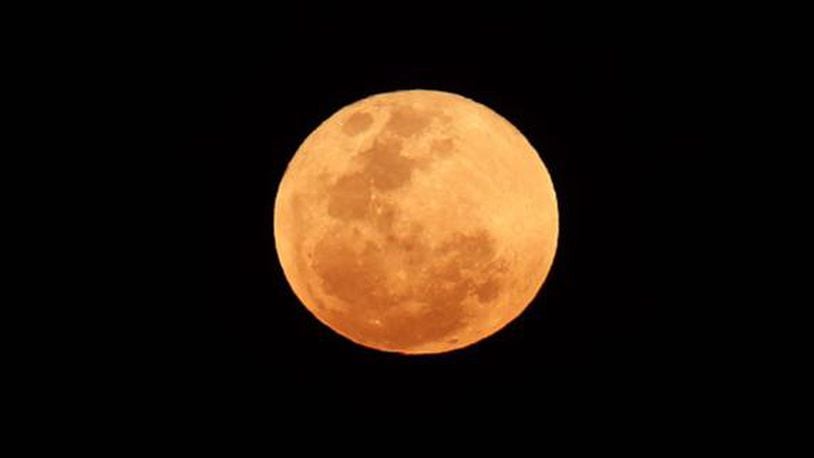The second full moon of the month, also known as the “Blue Moon,” will coincide with the total lunar eclipse, often referred to as a “blood moon” because the moon appears to be a reddish or copper color when moving through the Earth’s shadow.
This combined astronomical phenomenon hasn’t occurred since March 31, 1866.
To make the celestial event even more magnificent, the blue moon on Jan. 31 will be a supermoon, a term used to describe a full moon near or at the time when the moon is at its closest point in its orbit around the Earth.
According to NASA, supermoons may appear as much as 14 percent closer and 30 percent brighter than the moon on an average night.
Here's what you should know about the mega skywatching event:
What is a total lunar eclipse?
During a lunar eclipse, the Earth’s shadow blocks the sun’s light, which otherwise reflects off the moon. A total lunar eclipse occurs when the Earth’s dark umbral shadow completely covers the moon.
Who will be able to see the total eclipse?
Unlike August’s total solar eclipse, the Jan. 31 blue moon total lunar eclipse will not be as visible across the continental United States.
Credit: Matt Cardy
Credit: Matt Cardy
"Weather permitting, the West Coast, Alaska and Hawaii will have a spectacular view of totality from start to finish," Gordon Johnston, NASA program executive and lunar blogger, said in a statement. "Unfortunately, eclipse viewing will be more challenging in the Eastern time zone. The eclipse begins at 5:51 AM ET, as the Moon is about to set in the western sky, and the sky is getting lighter in the east."
Countries in Central and Eastern Asia, as well as Indonesia, New Zealand and much of Australia will see the celestial phenomenon.
Alaska, Hawaii and Northwestern Canada will also get to experience totality, but more eastern parts of North and Central America will have a much shorter show.
For the rest of the U.S., the eclipse will be too close to moonset for it to be visible.
Here's a map from EarthSky.org that shows the day and night sides of Earth at the time of greatest eclipse at 13:30 UTC (8:30 a.m. EST).
of greatest eclipse on Jan. 31. EarthSky.org
Only areas where it will be nighttime at 13:30 UTC will witness the greatest eclipse.
Parts of the Middle East and eastern Europe can view the ending stages of the partial umbral eclipse low in the east after sunset.
When will the blue moon total lunar eclipse start and end on Jan. 31?
The total eclipse begins at 12:52 UTC, with the greatest elipse at 13:30 UTC. It ends at 14:08 UT (9:08 a.m. EST).
The total eclipse will be visible in the night sky after sunset for those in the Middle East, Asia, Indonesia, Australia or New Zealand.
Total eclipse times in North America, according to EarthSky.org:
Eastern standard time
Partial umbral eclipse begins: 6:48 a.m. EST
Total eclipse not visible; moon sets beforehand
Central standard time
Partial umbral eclipse begins: 5:48 a.m. EST
Total eclipse begins: 6:52 a.m. CDT
Moon sets before totality ends
Mountain standard time
Partial umbral eclipse begins: 4:48 a.m. MST
Total eclipse begins: 5:52 a.m. MST
Greatest eclipse: 6:30 a.m. MST
Total eclipse ends: 7:08 a.m. MST
Pacific standard time
Partial umbral eclipse begins: 3:48 a.m. PST
Total eclipse begins: 4:52 a.m. PST
Greatest eclipse: 5:30 a.m. PST
Total eclipse ends: 6:08 a.m. PST
Alaskan standard time:
Partial umbral eclipse begins: 2:48 a.m. AKST
Total eclipse begins: 3:52 a.m. AKST
Greatest eclipse: 4:30 a.m. AKST
Total eclipse ends: 5:08 a.m. AKST
Hawaii-Aleutian standard time:
Partial umbral eclipse begins: 1:48 a.m. HAST
Total eclipse begins: 2:52 a.m. HAST
Greatest eclipse: 3:30 a.m. HAST
Total eclipse ends: 4:08 a.m. HAST
How long will totality last?
Totality will last about 77 minutes.
How to watch
If you're not able to view the Jan. 31 eclipse in your area, a live feed will be offered on NASA TV and NASA.gov/live.
You can also follow the eclipse on Twitter: @NASAMoon.
The Griffith Observatory in Los Angeles, California, will also be broadcasting it live. Watch at livestream.com/GriffithObservatoryTV.
A third option is to watch the livestream from the Virtual Telescope Project, which will show the view from telescopes in Australia and the U.S. Watch at virtualtelescope.eu.
When was the last blue moon total lunar eclipse?
This combined phenomenon hasn’t occurred since March 31, 1866.
When will the next blue moon total lunar eclipse occur?
The next time a blue moon will coincide with a total lunar eclipse will be Dec. 31, 2028.
How about the next total solar eclipse visible in the U.S.?
That won't occur until April 8, 2024.
About the Author
